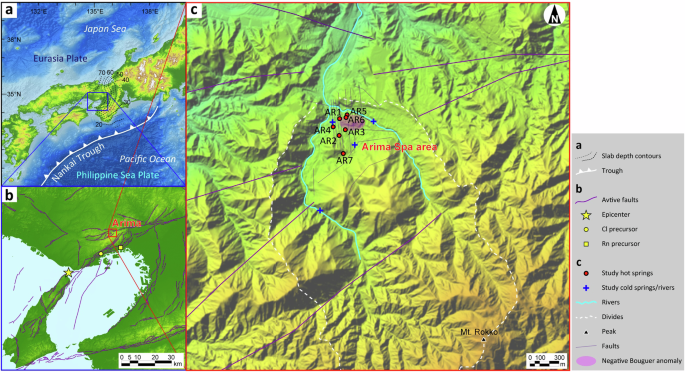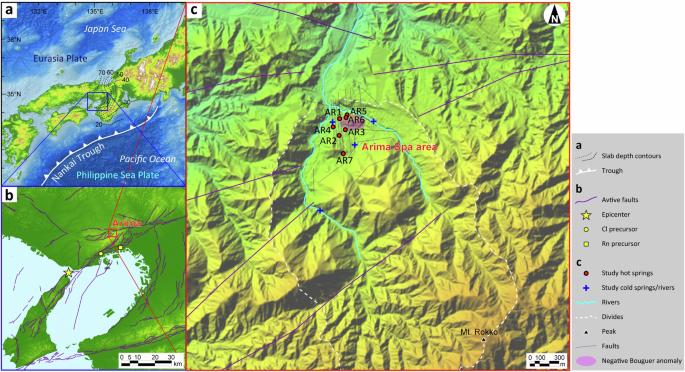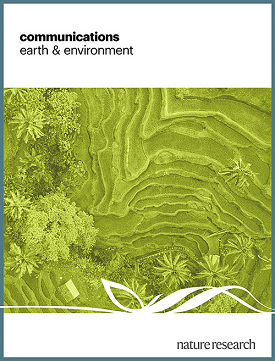Hot springs reflect the flooding of slab-derived water as a trigger of earthquakes
IF 8.1
1区 地球科学
Q1 ENVIRONMENTAL SCIENCES
引用次数: 0
Abstract
In subduction zones, water expelled from the subducting slab is believed to be involved in seismic activity. However, little is known about its quantity and flow processes. Here, we show that the Arima hot springs in western Japan contain high concentrations of water derived from the subducting Philippine Sea slab. A long-term record spanning over half a century reveals that the fraction of slab-derived water exhibited a temporary surge in the year preceding and/or subsequent years of the 1995 Kobe (Hyogo-ken Nanbu) earthquake. In total, an estimated 2.6–4.2 × 105 cubic meters of slab-derived water was introduced in conjunction with the earthquake. We infer that the earthquake was triggered by a flood-like release of water from the slab or by the bursting of clogged flow paths to the hypocenter. Our findings highlight the importance of hydrologically slab-connected hot springs for understanding ultradeep water cycles and their causal relationships with seismic phenomena. Water expelled from subducting slabs has a strong control over seismic events, with changes in hot spring water chemistry recording the surge of slab derived water, according to geochemical studies of water samples from the Arima hot springs, Japan.


温泉反映了触发地震的板块源水泛滥现象
在俯冲带,从俯冲板块中排出的水被认为与地震活动有关。然而,人们对其数量和流动过程知之甚少。在这里,我们发现日本西部的有马温泉含有大量来自俯冲菲律宾海板块的水。跨越半个多世纪的长期记录显示,在 1995 年神户(兵库县南部)地震的前一年和/或随后几年,板块衍生水的比例出现了短暂的激增。据估计,与地震同时发生的板层水总量为 2.6-4.2 × 105 立方米。我们推断,地震是由板坯中类似于洪水的水释放或流向震中的堵塞流道破裂引发的。我们的研究结果凸显了水文上与板块相连的温泉对于理解超深层水循环及其与地震现象的因果关系的重要性。根据对日本有马温泉水样本进行的地球化学研究,从俯冲板中排出的水对地震事件有很强的控制作用,温泉水化学成分的变化记录了板块衍生水的激增。
本文章由计算机程序翻译,如有差异,请以英文原文为准。
求助全文
约1分钟内获得全文
求助全文
来源期刊

Communications Earth & Environment
Earth and Planetary Sciences-General Earth and Planetary Sciences
CiteScore
8.60
自引率
2.50%
发文量
269
审稿时长
26 weeks
期刊介绍:
Communications Earth & Environment is an open access journal from Nature Portfolio publishing high-quality research, reviews and commentary in all areas of the Earth, environmental and planetary sciences. Research papers published by the journal represent significant advances that bring new insight to a specialized area in Earth science, planetary science or environmental science.
Communications Earth & Environment has a 2-year impact factor of 7.9 (2022 Journal Citation Reports®). Articles published in the journal in 2022 were downloaded 1,412,858 times. Median time from submission to the first editorial decision is 8 days.
文献相关原料
| 公司名称 | 产品信息 | 采购帮参考价格 |
|---|
 求助内容:
求助内容: 应助结果提醒方式:
应助结果提醒方式:


